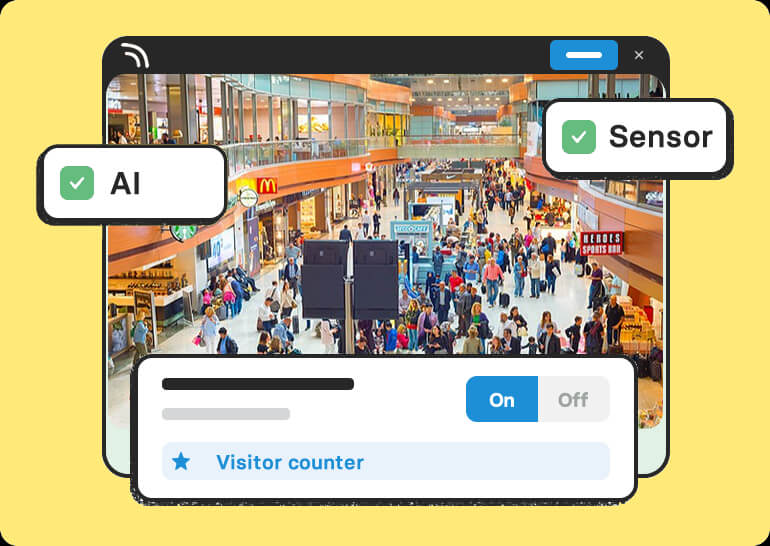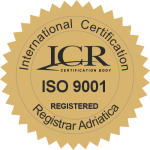Visitor Counter
Applications of Visitor Counters
A visitor counter is a device that uses an integrated sensor to track the number of people in a particular space during a specific time interval. Typically, this is done at the entrance or exit, where an electronic device automatically collects data about the counted visitors. The counting process is entirely anonymous, ensuring the privacy of each visitor.
Visitor counting solutions offer an objective source of reliable data, enabling you to analyze the attractiveness of your store, supermarket, institution, or even an entire city. With the data obtained through a visitor counter, you can easily adapt your strategy and prepare for future business ventures.
The process of visitor counting began with simple technologies like manual counters, requiring a store employee to stand by the entrance and click a counting device every time a person entered. Over time, the technology used for counting visitors has advanced.
The simplest visitor counters use an infrared beam across the entrance, usually connected to a small LCD display on the side of the door. Despite their limitations (such as less accuracy compared to newer generations), infrared counters remain widely used due to their low cost and easy installation.
Later, thermal visitor counters emerged in the mid-2000s. These systems utilize arrays of sensors that detect the heat emitted by human bodies. This generation of visitor counters boasts accuracy rates between 80% and 85%. Thermal counter models like the Irisys counters can achieve accuracy exceeding 95%.
The next generation of visitor counters is video counters, which use advanced algorithms and image processing to provide highly accurate analytics of visitor numbers and their demographics.
Installation and Support
Our IT specialists handle the installation and setup of the counters while providing all the necessary training to help you quickly access the data that can significantly improve your business – simply and efficiently.
Retail Stores
With competition from other physical stores, online shops, and more, today’s retail stores must make the most of every customer walking through their doors.
Without a clear understanding of customer behavior and conversion rates, retailers are forced to make decisions without critical insights into their shoppers. Accurate visitor counting and detailed retail analytics are crucial for making informed decisions. Retailers can use this data to measure and optimize conversion rates, staff scheduling, and the success of marketing campaigns.
Shopping Centers
Managing complex patterns of people movement in public spaces like shopping malls is challenging. As destinations, shopping centers must provide an environment that customers enjoy and want to visit, while also attracting tenants to lease space. Visitor counters can help understand customer movement, identify areas prone to crowding, and improve customer satisfaction. By identifying high and low-traffic areas, you can also set realistic rental prices for tenants. Ultimately, visitor counters enhance the shopping environment and make your mall stand out from competitors.
Supermarkets
Visitor counters can help supermarkets compete effectively. Experience repeatedly shows that understanding customers’ shopping habits (how, when, and where they shop) offers opportunities to improve customer service. This way, you can exceed expectations and encourage repeat visits.
Open Spaces and Cities
Various locations, from parks to city centers, require visitor counters. These counters are as effective outdoors as they are indoors. Counting visitors in cities can demonstrate success in tourism initiatives. Smart connected cities rely on accurate movement data to better understand how different areas are used, improving planning, infrastructure, and overall quality of urban life.
Public Institutions: Museums and Galleries
Museums, galleries, and other public institutions must accurately measure visitor numbers, as government grants and charitable donations often depend on these figures. Without the evidence provided by visitor counters, rough estimates may be the only proof of traffic, risking serious underestimation of your popularity.
Transportation Hubs: Airports and Stations
Airports, train stations, and other transport hubs are among the busiest locations in today’s world. Efficient operation of these areas requires the most accurate technology available. Counters provide transport hubs with a powerful tool for daily management, future planning, and ensuring everything runs as smoothly as possible while maintaining high levels of passenger satisfaction.
Frequently Asked Questions
Visitor counters use sensor technologies such as infrared beams, thermal sensors, and video analytics to automatically count passages through a designated area. The process is anonymous and does not store personal data.
Accuracy depends on the technology type:
- Infrared counters: up to 85% accuracy.
- Thermal counters: between 90% and 95% accuracy.
- Video counters with advanced algorithms: more than 98% accuracy.
Yes, all our visitor counters are fully anonymous and do not record personal data or user identity, meeting all GDPR requirements.
Counters are useful in:
- Retail stores for optimizing conversion rates.
- Supermarkets for analyzing shopping habits.
- Shopping centers for space management.
- Public institutions like museums for measuring attendance.
- Airports and stations for better traffic organization.
Data enables you to:
- Better plan staff schedules.
- Analyze the success of marketing campaigns.
- Optimize movement protocols within spaces.
- Make data-driven decisions instead of relying on assumptions.
Our IT specialists provide full installation and training. The system requires minimal maintenance, and data access is straightforward via a user-friendly interface.
Yes, our visitor counters can be used in outdoor environments, including parks, city centers, and tourist locations.
Costs depend on the technology type and the size of your space. However, the investment quickly pays off through increased business efficiency and cost optimization.
Ready to measure traffic accurately?

